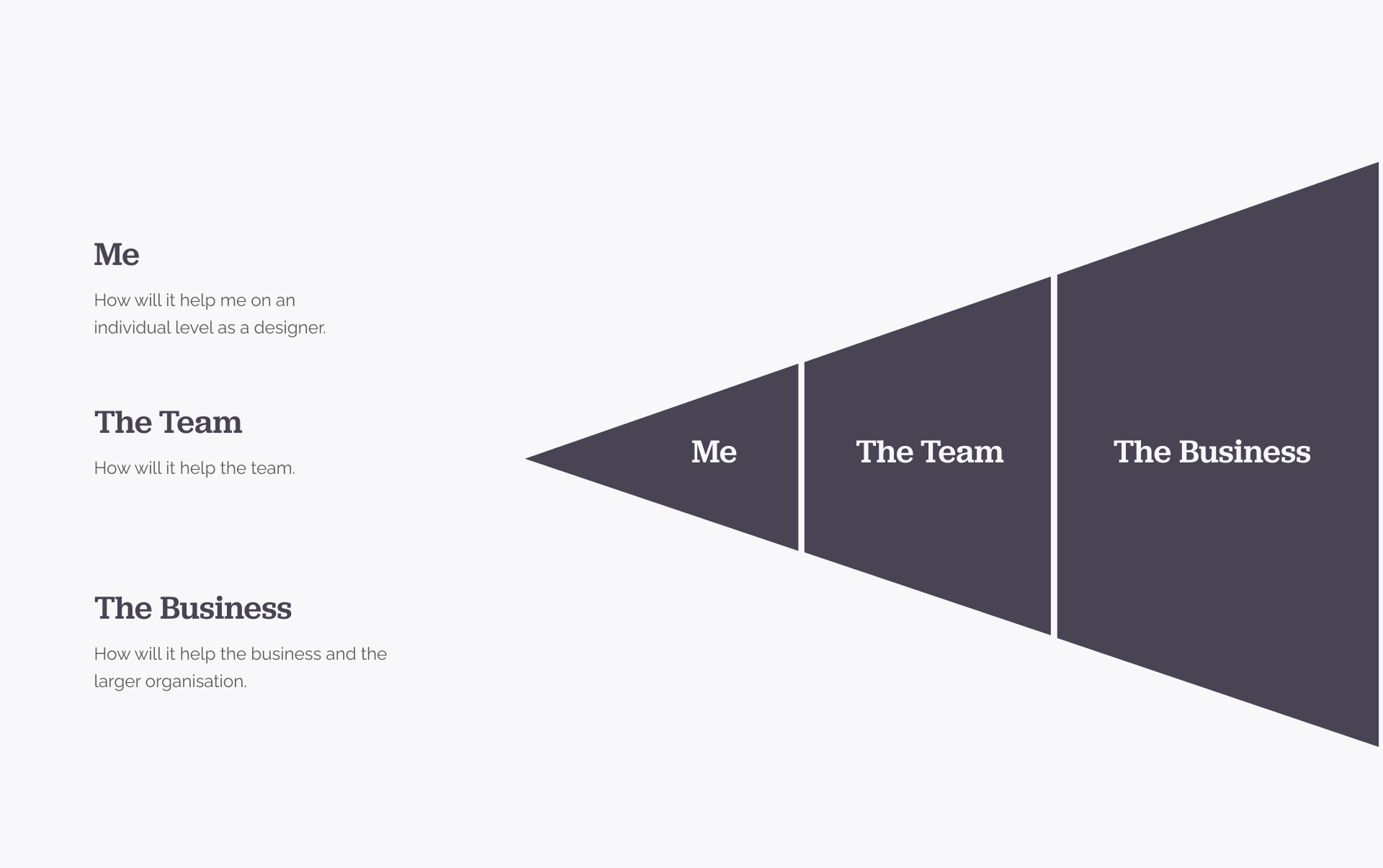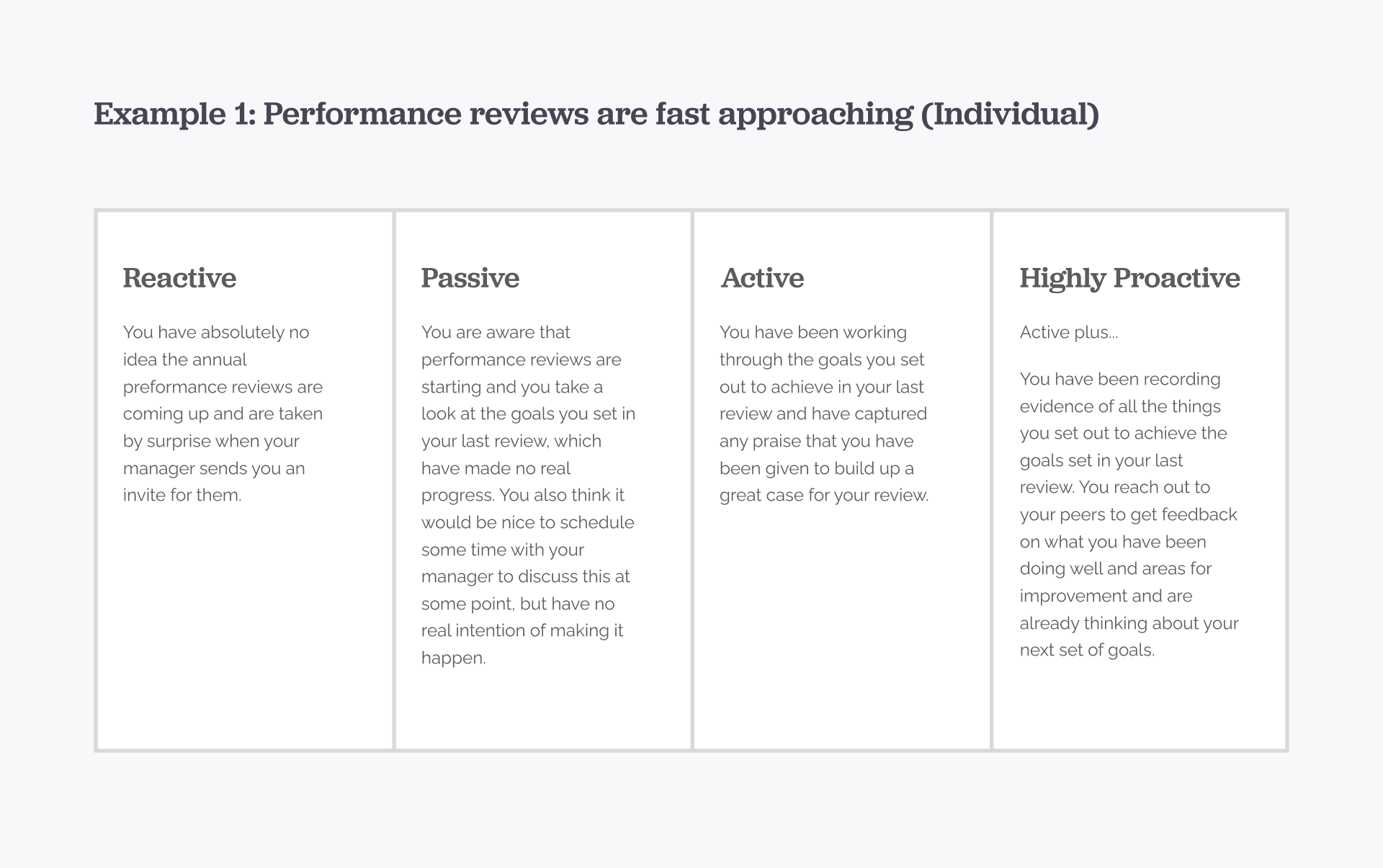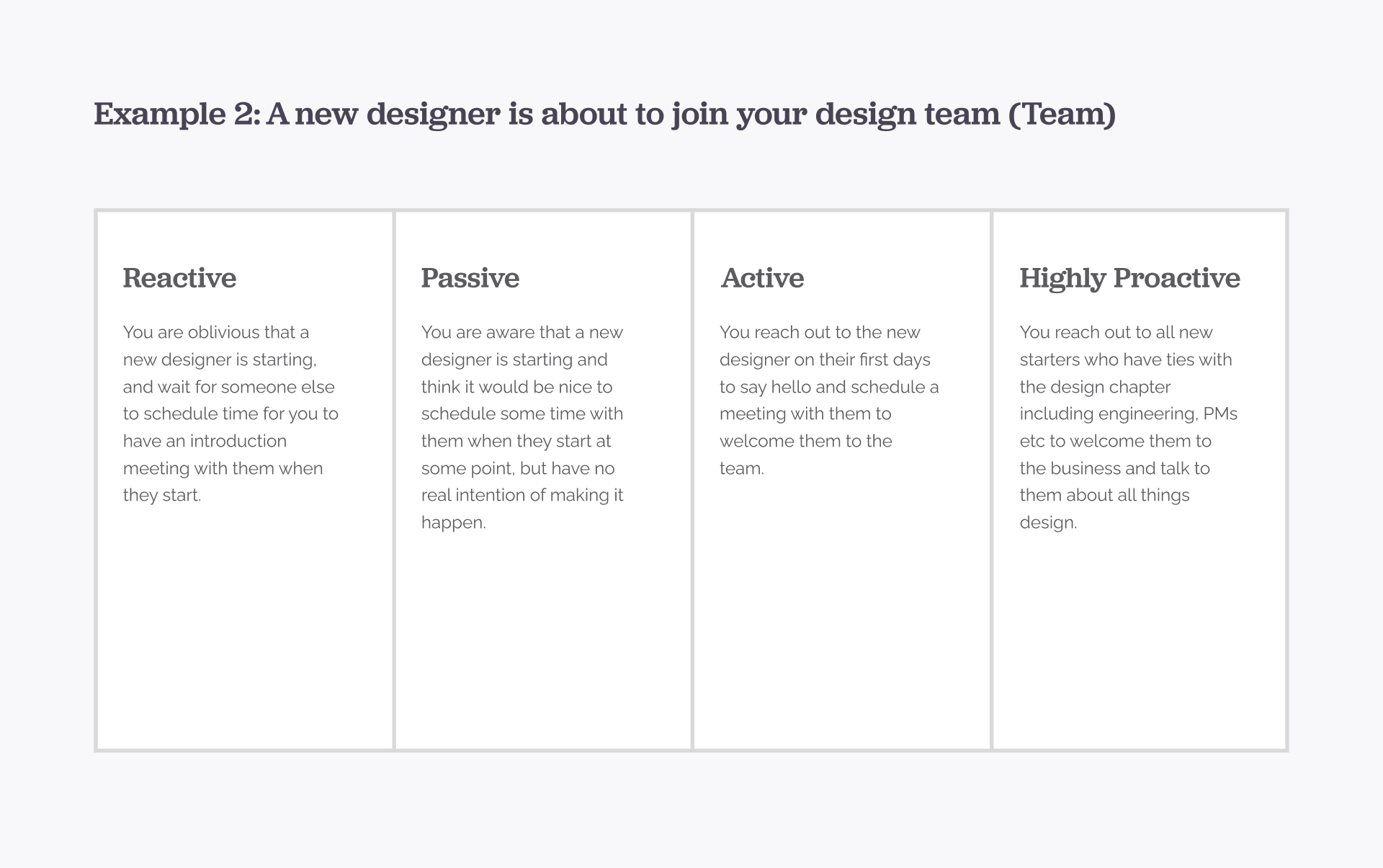Unleashing Creative Potential,
Why Proactivity is Key to Design Excellence
May 2021. 6 min read
As a Designer, proactivity is a crucial skill that goes hand-in-hand with other essential core values like curiosity, humility, and empathy. If you struggle with proactivity, don't worry - with conscious effort and practice, it can be developed and refined over time to help you excel in your role.
You'll find that being proactive has countless benefits, particularly when it comes to accelerating your career. By taking initiative, anticipating problems, and identifying opportunities, you showcase a level of commitment and dedication that builds trust amongst your peers. This trust is invaluable within a team, as it builds stronger relationships, which can lead to more ownership and responsibility, and ultimately greater opportunities for you personally and professionally.
No matter where you are in your design career, you can start being more proactive today. In this guide, I'll share some key insights and practical tips that have helped me cultivate trust with my team and grow as a designer through proactivity. These tips are based on my own experiences, and I hope they can help you build stronger relationships and achieve greater success in your own career. But first, let's take a deep dive into proactivity to better understand what it means.
• • •
Proactivity. What is it?
As the dictionary defines it; Proactive means to act in anticipation of future problems, needs, or changes. In other words, being proactive means taking charge and controlling situations, rather than responding to situations as they arise. It also means taking responsibility for mistakes or when things go wrong. This can be challenging but is an essential step as a designer towards cultivating resilience and fostering a growth mindset that enables you to identify new opportunities for learning and growth.
If you want to achieve your goals with more confidence and ease, proactivity is a cornerstone of the '7 Habits of Highly Effective People.' It's not about overwhelming yourself with tasks, but rather prioritising and focusing on the things that matter and are within your control. To be proactive as a designer, you need to take a strategic approach to problem-solving, identifying the most critical issues and tackling them head-on to avoid getting bogged down by tasks outside your circle of influence. Navigating this should be a breeze, as it is something that you are likely already very familiar with in the world of design.
The benefits of a proactive mindset
While it may take a period of adjustment to embrace a proactive mindset, the positive benefits are endless. Growth is undoubtedly the most significant benefit of adopting a proactive approach, however, it is important to note that there are several other advantages including;
Sense of control: The ability to plan, organise and manage design work effectively. This may involve setting and achieving goals, creating systems to manage time and tasks, and taking responsibility for decisions and actions.
Anticipation and adaptability: The ability to identify potential challenges or obstacles in advance and develop solutions to address them. This may involve staying attuned to changing circumstances, developing contingency plans, and seeking feedback and support from others as needed in your day-to-day.
Work-life balance and job satisfaction: The ability to achieve a healthy and sustainable balance between work and life. This may involve setting boundaries around work time, getting involved in activities that promote overall well-being in and outside of your working life, and actively seeking out opportunities to fulfill your career and life beyond that.
• • •
Thinking and behaving proactively
Proactivity can be broken down into two categories: thinking and behaviour.
Thinking proactively means anticipating problems and identifying opportunities before they arise; and
Behaving proactively means taking the initiative to address issues and make the most of potential opportunities.
By mastering both, you can develop the skills necessary to shape team dynamics, influence project direction, and advance your career.
• • •
The scale of proactivity
While some people are reactive and passive, others are highly proactive and take the initiative to shape their careers and beyond. Regardless of where you sit on the scale, there are always opportunities to become more proactive. Here is some context to help you better understand the scale of proactivity.
At the lowest end of the scale, reactive individuals tend to be passive and merely respond to situations as they occur without taking the initiative to improve their circumstances or seek out opportunities. Those in the passive category may recognise the importance of proactivity but lack the motivation to take consistent action toward their goals. On the other hand, active individuals regularly seek to improve their situation, develop new skills, and overcome challenges to achieve their goals. Finally, highly proactive individuals consistently take bold action to create their ideal life. They set ambitious goals, explore new possibilities, and take control of every aspect.
It’s important to note that you may find yourself in different positions on the proactivity scale depending on your current mindset and habits. For example, during times of stress or uncertainty, you may find yourself being more reactive and passive, responding to situations as they arise instead of taking the initiative to shape them. On the other hand, during periods of stability and motivation, you may find yourself more proactive, seeking out opportunities and taking control of your circumstances.
Similarly, even individuals who typically exhibit proactive behaviour can find themselves becoming complacent and less proactive when facing a lack of motivation or a sense of discouragement. It's important to stay aware of your own proactivity levels and continuously work on developing and maintaining a proactive mindset.
Being proactive is not one-size-fits-all and will show up differently depending on the situation you’re in. That being said, when you look at yourself as a designer through proactivity you have the ability to create influence — not just on your personal development and career, but also contributions to your team and impact on the wider business goals and vision.
Using this framework let’s have a look at some example situations across these, and the levels of being proactive within. Ask yourself — do you tend to sit on the reactive end or are you already proactive?
What next?
Great, so now you understand what a proactive designer might look like, but how do you go from being where you are to being more proactive in your everyday?
Thinking proactively
As a designer, you will already be aware that asking insightful questions and approaching challenges with a sense of curiosity is an essential skill in the design process. These skills go hand in hand with proactivity, enabling you to take the lead and shape your own creative journey.
Here are some initial questions you can ask yourself to start thinking more proactively:
Gain a better sense of control:
What am I experiencing right now?
What are my colleagues or team members experiencing?
How can I use this information to make better decisions and take action?
What can I do to make a difference?
What steps can I take to move things forward?
Anticipate and adapt better to change:
What are the potential challenges I might face?
How can I plan for these challenges and reduce their impact?
What are the potential opportunities for change?
How can I be ready to adapt to these changes and take advantage of them?
Achieve a better work-life balance and job satisfaction:
What am I not doing today, that I want to be doing?
What am doing today, that I don’t want to be doing?
Behaving proactively
With this knowledge comes power. The power to take personal responsibility and behave proactively. Below are some core steps and ways to go from thinking proactively, to behaving proactively and accelerating yourself both professionally and personally.
Organise and prioritise: You may have a few big opportunities or lots of little ones. Start by organising and collating the opportunities and prioritising these; whether it impacts vs effort, based on your personal passion, or another measure. Figure out which opportunities are best to tackle first and will create the biggest impact; for yourself, the team, or the business.
Make a plan and get started: Break down the top priority tasks, and create a plan of action to achieve these. Make sure to draw on your past experiences, and anticipate any possible obstacles. These small bite-sized and achievable tasks help you continue to make progress. Using a proactive mindset, put your plan into action and get started on making continuous progress, and creating ongoing impact.
Measure progress and iterate: Make an effort to measure your progress towards a task, I like to celebrate the wins along the way to stay motivated. Keeping track enables you to see where you are making progress, and where you may not be giving space to reflect and iterate on the process and unknown obstacles, of potential pivots that may come up along the way. Remember being proactive isn’t about being right, but about creating action, and foreseeing potential blockers to pivot around them.
Seek feedback, reflect, and refine: Being proactive takes practice, seek feedback from those you’ve worked with along the way to gain fresh perspectives and reflect on your personal experiences to identify valuable lessons that you can apply next time.
Repeat step 1: Take those learnings and lessons and do it all over again. Once you’ve mastered it you might want to help someone else be proactive through mentoring, and guiding them to follow a similar process.
• • •
Being proactive as a designer is really about working smarter and being flexible to think 2 steps ahead and anticipate challenges. It is a skill that requires consistent effort, dedication, and constant improvement — as many things in life do. One quote that perfectly encapsulates the productive mindset that every designer should strive for is "Be the leader you wish you had." By embodying this, you can make a real impact not just on yourself and your career, but on your team and the work you deliver, and the wider business mission.




